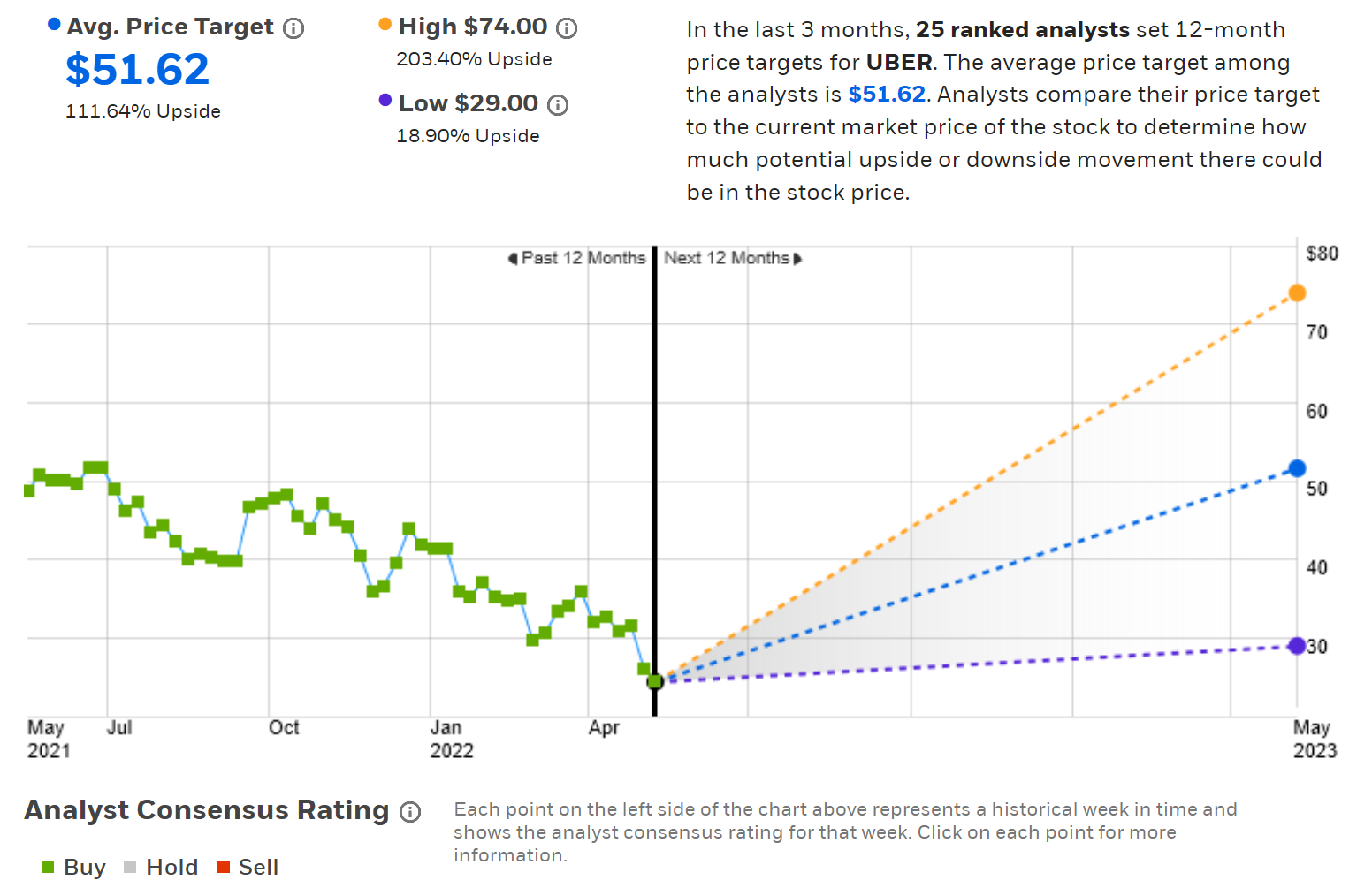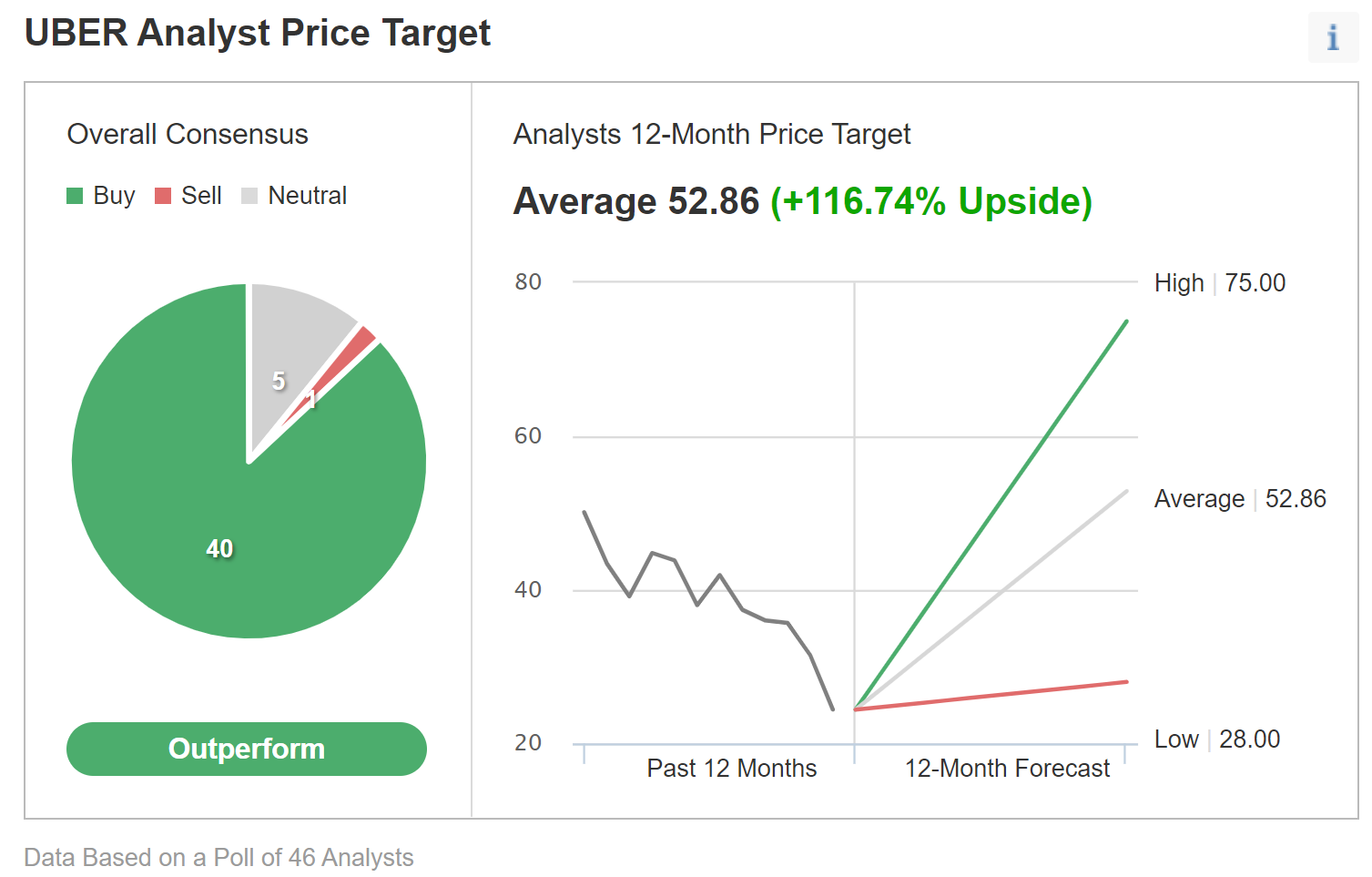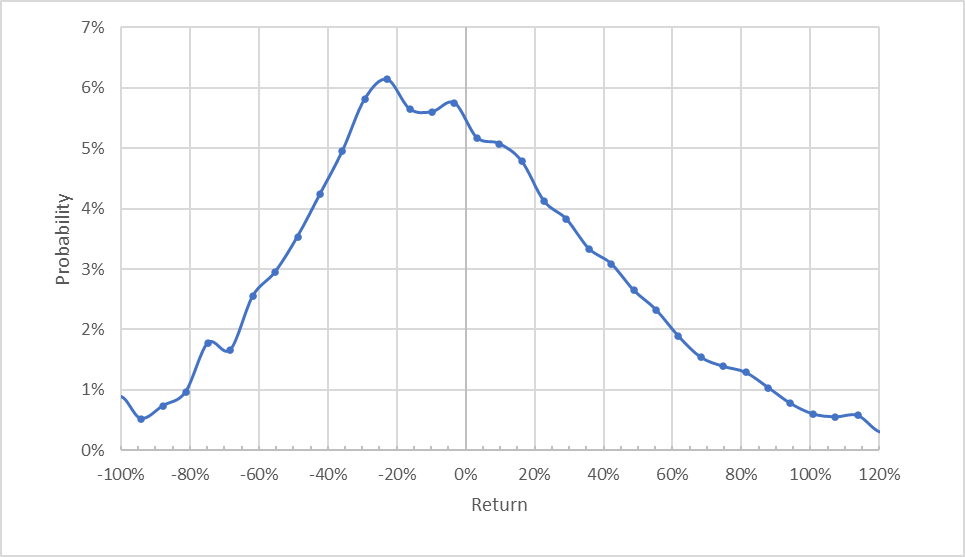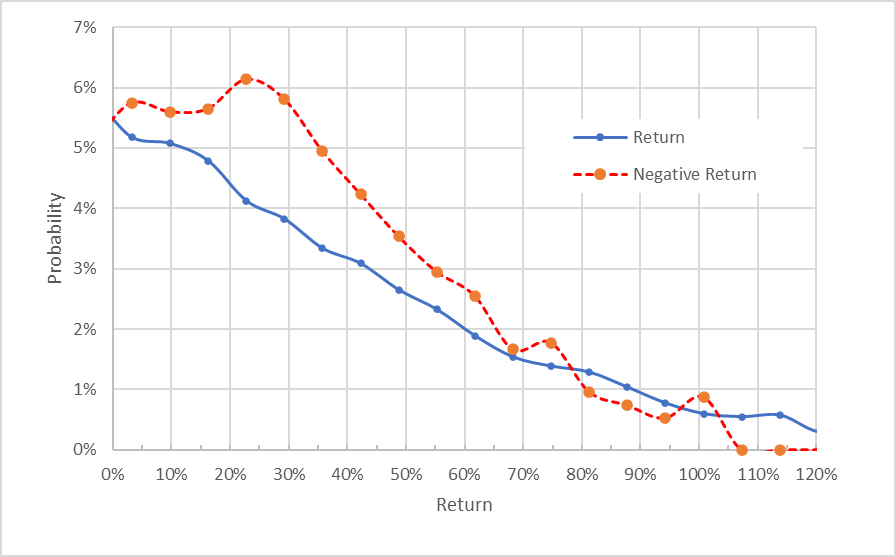- UBER is down 42% so far in 2022
- Q1 results on May 4, substantially missed expectations
- Higher gas prices and increasing service-sector wages challenging
- Consensus outlook bullish, but very large spread in analyst price targets
- Market-implied outlook is bearish, with high volatility
- For tools, data, and content to help you make better investing decisions, try InvestingPro+
- Inflation
- Geopolitical turmoil
- Disruptive technologies
- Interest rate hikes
Uber Technologies (NYSE:UBER) reported Q1 2022 results on May 4, dramatically underperforming earnings expectations. The consensus expected EPS was -$0.26 per share and the actual Q1 EPS was -$3.04 per share.
The shares dropped on the news, continuing a huge decline over the past year. The shares have returned -25.25% over the past month, -41.8% so far in 2022, and -13.1% per year over the past 3 years.

Source: Investing.com
UBER has built a global brand that has substantially reshaped the taxi business. The company has also expanded into food delivery services. The food delivery business, Uber Eats, grew substantially during the pandemic, helping to offset declines in revenues from ride hailing. The demand for rides has rebounded substantially, with the current levels of Uber ride bookings returning to pre-COVID levels (see slide 6).
Looking at the ride hailing business model, the disruptive features have the potential to be a significant drag. UBER (and LYFT) (NASDAQ:LYFT) have demonstrated that a tech platform with on-demand gig drivers could compete with taxi services. Becoming a taxi driver has substantial barriers to entry, most notably the high cost of purchasing a taxi medallion. By empowering gig workers with a ride hailing platform, there is almost no barrier to entry. These gig drivers should be willing to earn substantially less than tax drivers because of the lower investment.
In some sense, this is a form of labor arbitrage. The problem, however, is that the significant investment required to become a taxi driver has some important economic effects. First, with taxis, there is a limited population of drivers, which keeps fares from falling too low. Second, taxi drivers have an economic incentive to continue to drive even during less profitable periods because of their investment. The ride hailing / gig driver model has neither of these effects. As the price of fuel rises and wages for service jobs have surged, it is harder for UBER to compete with alternative jobs. This reduces the supply of drivers and raises fares, making ride hailing less attractive. In addition, fare increase with a falling supply of drivers, which makes ride hailing less competitive with alternatives. See this Europe-focused discussion.
Part of UBER’s decline is attributable to rising interest rates. Growth stocks, and especially those that are not profitable, are very sensitive to interest rates. The discount rate used to value stocks rises with interest rates. A stock for which much of the value is derived from earnings significantly in the future falls more with rising rates than the broader market.
On Oct. 6, 2021, when the shares were trading at $45.70, and I assigned a neutral / hold rating, I based my rating on two forms of consensus outlooks for UBER. The first was the well-known Wall Street analyst consensus rating and price target. The second was the market-implied outlook, which represents the consensus view among buyers and sellers of options.
The Wall Street consensus outlook was bullish, with a consensus 12-month price target that was almost 50% above the share price at that time. The market-implied outlook, by contrast, was substantially bearish, with a high probability for significant price declines to the middle of 2022. In considering these two conflicting views, I compromised with a neutral rating. UBER is currently trading at $24.39, 46.6% below the share price on Oct. 6.
For readers who are unfamiliar with the market-implied outlook, a brief explanation is needed. The price of an option on a stock reflects the market’s consensus estimate of the probability that the share price will rise above (call option) or fall below (put option) a specific level (the option strike price) between now and when the option expires. By analyzing the prices of call and put options at a range of strike prices, all with the same expiration date, it is possible to calculate a probabilistic price forecast that reconciles the options prices. This is the market-implied outlook and represents the consensus view implicit in the distribution of options prices. For a deeper discussion than is provided here and in the previous link, I recommend this monograph from the CFA Institute.
Since my previous article, conditions have generally worsened for ride hailing companies. Inflation continues to increase at multi-decade high rates. There is no near-term expectation that gas prices will decline. And, of course, wages are rising as the unemployment rate remains very low. I have calculated the market-implied outlook for UBER to early 2023 and I have compared this with the current Wall Street analyst consensus outlook in revisiting my opinion.
Wall Street Consensus Outlook for UBER
E-Trade calculates the Wall Street consensus outlook for UBER by combining ratings and price targets from 25 ranked analysts who have published their view within the past 3 months. The consensus rating is bullish and the consensus 12-month price target is $51.62, more than twice the current share price. The consensus rating has been continuously bullish over the past year, as the share price has dropped substantially. I don’t put much weight on the consensus price target because the dispersion among the individual analyst’s price targets is so high. Research has shown that there is a negative correlation between returns implied by the consensus price target and subsequent returns when the dispersion in individual price targets is large. The high return expected from the consensus combined with the high dispersion would be a bearish indicator, according to this study. As a rule of thumb, I largely or entirely discount the consensus price target when the highest price target is at least twice the lowest. In this case, the difference is a factor of 2.6X ($74 vs. $29).

Source: E-Trade
Investing.com’s version of the Wall Street consensus outlook is calculated using price targets and ratings from 46 analysts, and the results are very similar to those from E-Trade. The consensus rating is bullish and the consensus 12-month price target implies a 117% expected return (as compared to 112% from E-Trade). The dispersion in the individual price targets is also very high.

Source: Investing.com
On the positive side, the consensus rating is bullish and the consensus 12-month price target implies expected return above 100%. To the contrary, the high dispersion in the price target, which reflects a large amount of disagreement among analysts, combined with the high implied returns has tended to be a bearish indicator. It is worth noting that the consensus 12-month price target is quite close to the trailing 12-month high, $51.70.
Market-Implied Outlook for UBER
I have calculated the market-implied outlook for UBER for the 8.2-month period between now and January 20, 2023, using the prices of call and put options that expire on this date. I selected this specific expiration date to provide a view through the end of 2022 and because the options expiring in January tend to be among the most actively traded.
The standard presentation of the market-implied outlook is a probability distribution of price return, with probability on the vertical axis and return on the horizontal.

Source: Author’s calculations using options quotes from E-Trade
The outlook for the next 8.2 months is tilted to favor negative returns, with the maximum probability corresponding to a price return of -23%. The expected volatility calculated from this outlook is 60%. The distribution is significantly positively skewed, which tends to predict lower future returns for a stock. This is a bearish outlook for UBER to early 2022.
To make it easier to directly compare the probabilities of positive and negative returns, I rotate the negative return side of the distribution about the vertical axis (see chart below).

Source: Author’s calculations using options quotes from E-Trade
This view highlights that the probability of having a negative return tends to be substantially higher than the probability of a positive return of the same magnitude, across a wide range of the most probable outcomes (the dashed red line is well above the solid blue line over most of the left ½ of the chart above).
While theory suggests that the market-implied outlook should tend to have a negative bias, there is no way to measure whether this bias is present. Considering the magnitude of the spread between positive and negative return probabilities in the context of the many case studies that I have run, I interpret this outlook as significantly bearish.
I had an 8.3-month outlook in my previous analysis, going from early October of 2021 to mid-June of 2022, which provides an interesting basis for comparison. The 8.3-month outlook from early October is quite similar to the new 8.2-month outlook to early 2023.
Summary
Uber’s share price has fallen almost 42% so far in 2022. Some of this decline is due to rising interest rates and a shift in investor sentiment away from high-growth names, but there are a number of significant underlying economic concerns as well.
The at-will nature of ride hailing has resulted in a decline in drivers as gas prices and service industry wages have risen. In addition, the costs of ride hailing services have risen. There is no reason to believe that this situation will change. While food delivery is a growing part of Uber’s business, this business is not immune to rising fuel costs and rising wages.
The Wall Street consensus outlook continues to be bullish, as it was when I analyzed UBER in October last year and, even earlier, in July of 2021. In both cases, the market-implied outlook was bearish, as it continues to be today.
For both my July and October posts, the consensus 12-month price target implied about a 50% gain. Today, the consensus 12-month price target implies a 110% gain. The dispersion among the analyst price targets has gotten wider over time, such that the current spread in views leads me to discount the Wall Street consensus. I am changing my rating on UBER to sell / bearish.
The current market makes it harder than ever to make the right decisions. Think about the challenges:
To handle them, you need good data, effective tools to sort through the data, and insights into what it all means. You need to take emotion out of investing and focus on the fundamentals.
For that, there’s InvestingPro+, with all the professional data and tools you need to make better investing decisions. Learn More »
